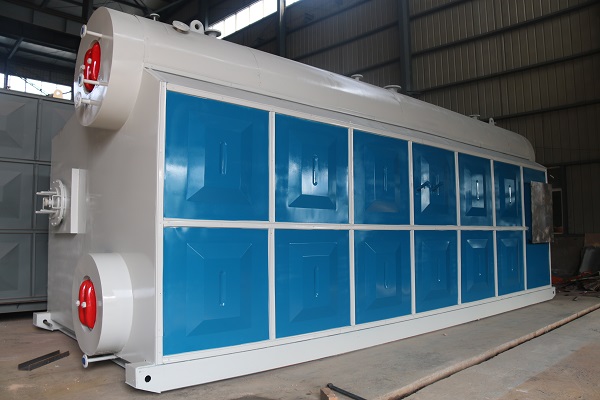


What are the causes of gas boiler deflagration? How to prevent it?
date:2021-11-05 09:35:00
The deflagration of a gas boiler is a very serious failure. In recent years, with the widespread popularity of products, news about boiler deflagration is also commonplace. The power of boiler deflagration and explosion is very huge. Some boilers will also form multiple deflagration and explosion phenomena, which is listed as one of the major national safety precautions in my country. . Next, let's get familiar with the conditions, causes and preventive measures of boiler deflagration.

1 The working principle of the burner
First of all, here is a brief introduction to the working principle of the gas boiler.
1.1 burner start
When the system receives an automatic or manual start-up command, the burner program controller starts to run, and the following combustion steps are executed without any abnormal alarm signal.
1.2 leak detection
The programmable controller performs leak detection on its own through the pressure switch of the double solenoid valve for leak detection. If the solenoid valve leaks, the burner stops running and outputs an alarm signal; if the leak detection passes, the purge step is performed.
1.3 Purge before
The fan baffle turns from the closed state to the high wind position (high fire position), the servo motor turns to the upper limit position, the fan baffle stops at the "high fire position" for 30s before purging, and the servo motor stops at the upper limit position. During this period, the wind pressure switch will send the detected wind pressure signal to the programmer to detect the normal operation of the fan.
1.4 ignition
After the front purging is completed, the damper flap returns to the ignition position, and the servo motor stops at the ignition position. The burner automatically starts the ignition transformer (the ignition transformer is energized, and the ignition electrode discharges and ignites). After the ignition electrode is ignited for 1 to 3 seconds, the solenoid valve of the ignition gas circuit is automatically opened, and the ignition flame is established. At this time, the flame probe will continuously feedback the detected flame signal to the programmer. If the flame is not detected, the burner will stop working. And output an alarm.
1.5 The main flame is established
3s after the ignition solenoid valve is opened, the ignition transformer loses power (power off), and the ignition electrode stops discharging. At the same time, the main circuit solenoid valve (leak detection solenoid valve) is opened (powered), and the main flame is established.
1.6 normal operation
After the main circuit solenoid valve (leak detection solenoid valve) is opened for 2 seconds, the ignition gas circuit solenoid valve is de-energized (closed) and the corresponding indicator light on the flowchart goes out. After another 2s, the combustion enters the proportional automatic adjustment state (see Figure 1 for the ignition control timing).
2 Analysis of the cause of the deflagration event of the thermal medium furnace
Analyze the deflagration event of the thermal medium furnace and find the root cause of the deflagration:
2.1 Event background
A deflagration event occurred when the heat medium furnace continued to ignite after several ignition failures.
2.2 Cause analysis
1) Check the gas solenoid valve of the heat medium furnace, check the pressure switch attached to it, and conduct an air-tight test on the solenoid valve. It is found that the condition is normal and the cause of the solenoid valve leakage is eliminated;
2) Test several burner safety-related accessories such as flame probe, wind pressure switch, ignition electrode, etc., and find that everything is normal, and eliminate the possibility of failure of the above components;
3) Check the blower and the servo motor, the fan can operate normally, the operation of the servo motor and the opening and closing of the damper are smooth, and further eliminate the possibility of fan and damper failure;
4) Opening the furnace and inspecting the internal structure of the burner, it was found that the flame stabilization plate of the burner was seriously damaged due to high temperature, corrosion and other reasons. According to this point, the cause of the boiler deflagration was further analyzed:
A) The heat medium furnace flame stabilizing plate has been in service for a long time and is seriously damaged. It cannot form a normal flame during ignition, which can easily lead to abnormal flameout, resulting in ignition failure, and ignition failure causes unburned or incomplete combustible gas to remain in the furnace;
b) High air position (large fire position) Due to production requirements, the boiler load adjustment has been set at a relatively small opening, so that the maximum air door position of the burner before blowing or blowing after ignition failure is always at a small opening In this state, the burner is not effectively and thoroughly purged during the purging stage, resulting in continued residual combustible gas in the furnace;
C) Multiple ignition failures and insufficient pre-purging make the residual combustible gas in the furnace accumulate more and more. When the mixture of combustible gas and air reaches its explosive limit, deflagration will occur as soon as it encounters an open flame.
The above analysis of the reasons is exactly consistent with the phenomenon that the heat medium furnace has failed to ignite for many times, and deflagration suddenly occurs when it is re-ignited.
2.3 Troubleshooting
In response to the deflagration incident, we have made the following improvements to the equipment and management:
A) Replace the faulty flame stabilizing plate;
B) Re-adjust the upper limit of the servo motor (that is, the high fire position), and it is strictly forbidden to change it at will;
C) Develop a maintenance system for burners and strictly implement them;
D) Formulate the boiler operation manual, and stipulate that the ignition shall not be re-ignited after the ignition fails 3 times, and the boiler can be started again after the relevant technicians make an inspection and force the furnace to be purged again.
3 Conditions and possible reasons for the occurrence of a deflagration event
Finally, the conditions for the occurrence of deflagration events are combined with the current working principle of automatic ignition gas boilers to analyze the possible causes of deflagration of gas boilers.
3.1 The deflagration of a gas boiler can only occur when the following three conditions are met at the same time:
A) There is enough combustible gas and air trapped in the furnace,
B) The mixture of combustible gas and air reaches a certain concentration,
C) There is enough energy to ignite the mixture in the furnace.
All in all, when the mixture of combustible gas and air in the furnace meets an open flame at a certain concentration or reaches above its ignition point temperature, it is prone to boiler deflagration accidents, and the higher the pressure and temperature of the mixture, the greater the explosion hazard. .
3.2 At present, the burners used in the Oriental Terminal are all equipped with automatic ignition function. According to its principle, the possible causes of a deflagration event are mainly as follows:
a) Insufficient pre-purge time, or insufficient opening of the air door during purging, resulting in insufficient purging of the combustible gas remaining in the furnace. When the mixture of the remaining combustible gas and air reaches a certain concentration, the When the energy is sufficient to ignite the mixture, a deflagration accident will occur.
b) The fuel gas solenoid valve leaks, causing the furnace chamber to be fully purged, but because the fuel gas continues to leak into the furnace chamber, the mixture of combustible gas and air leaking into the furnace chamber is enough to cause a deflagration accident when the purge is stopped and ready for ignition. happened.
C) The failure of the flameout protection device caused the gas valve of the burner to not close in time after the abnormal flameout, and the combustible gas entered the furnace, causing a deflagration accident under high temperature conditions.
d) The ratio of fuel gas to air is improper. Too much or too little air volume causes the combustible gas to not be fully burned in the furnace. Part of the combustible gas is taken to a certain part of the flue. When certain conditions are met, it will produce two Second combustion or deflagration.
E) After multiple ignition failures, without finding the cause and forcing the furnace to be purged for a long time, it may also cause the boiler to deflagrate.
4 How to prevent the occurrence of gas boiler deflagration
At present, with the high degree of automation, most of the burners have realized the automatic control function, and for the use of automatic ignition gas boilers, generally there are flameout protection, wind pressure protection, valve inspection in the key safety protection. Functions such as leakage, purge before ignition, purge after ignition, flame monitoring, etc., but there is also the possibility of furnace deflagration. The following preventive measures will be taken for the reasons mentioned earlier in this article that cause boiler deflagration :
4.1 Furnace purging aspect
It is necessary to ensure sufficient purge time before ignition and purge after ignition failure. If necessary, the purge time can be appropriately extended by modifying the PLC program; at the same time, it is strictly forbidden to adjust the upper limit of the servo motor (that is, the maximum damper position) at will. Ensure that the opening of the air door is large enough for the furnace to be effectively purged, and to avoid the occurrence of inadequate purging that causes combustible gas to stay in the furnace.
4.2 Leak detection solenoid valve self-check aspect
Regular inspection and testing of the leakage detection solenoid valve to ensure its reliability and avoid greater deflagration accidents caused by gas leakage due to equipment failure.
4.3 wind pressure monitoring and flame monitoring
Regularly complete the maintenance of the wind pressure detection switch and flame detection probe and the safety test of the automatic control system to ensure the safety and reliability of the equipment.
4.4 Fuel gas and air ratio
Regularly check the exhaust gas of the boiler, and use the flue gas analyzer to adjust the air reasonably.
4.5 Strengthen personnel training, and develop detailed operation manuals and emergency response plans
4.6 Develop quarterly or semi-annual burner in-depth maintenance plan, know the condition of the equipment, and arrange the maintenance plan reasonably
After fully analyzing the causes of deflagration of gas-fired boilers and formulating comprehensive preventive measures, it is necessary to overcome the fear of deflagration accidents and operate on the principle of courage and carefulness. At the same time, it is necessary to "stabilize" when an accident occurs. "Accurately, quickly" to deal with accidents, and resolutely put an end to the scope of the accident expanded due to operating errors.
Contact Us
Resolve Your Problems within One Minute



Address:No.11 Minhe Road, Private Industrial Park, Development Zone, Kaifeng City
Inquiry
If you have any questions about our company and products, please contact us immediately. Any inquiries and Suggestions would be appreciated.
We will keep your information confidential.








